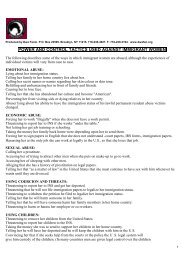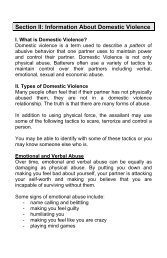Domestic Violence Counseling Manual - Hot Peach Pages
Domestic Violence Counseling Manual - Hot Peach Pages
Domestic Violence Counseling Manual - Hot Peach Pages
Create successful ePaper yourself
Turn your PDF publications into a flip-book with our unique Google optimized e-Paper software.
• Treatment: Treatments for genital warts include topical application of various medicines,<br />
cryotherapy, or laser surgery. Most people are cleared of warts by the first series of treatments.<br />
Warts recur for some people, however, during several months after treatment — especially if they<br />
smoke cigarettes, and some people continue to have recurrences after long periods of time.<br />
5. Hepatitis B<br />
The Hepatitis B Virus (HBV) is found in bodily fluid and excretions; concentrations in blood and<br />
semen are the most contagious.<br />
• Transmission: HBV is transmitted through sexual intercourse or needle sharing with infected<br />
individuals. HBV can also be spread through oral sex and kissing. Individuals who have been<br />
vaccinated for Hepatitis B are not at risk of contracting the virus.<br />
• Symptoms: Many cases of HBV are asymptomatic. Early symptoms may include nausea,<br />
general malaise, fever, and loss of appetite. Symptoms can last several days to several weeks. In<br />
the later stages, dark urine or jaundice (yellowing of the skin) may appear. HBV can result in the<br />
hardening of the liver and cancer. Very serious cases of HBV are sometimes fatal. HBV is a<br />
virus, and infected individuals typically carry it for their lifetimes.<br />
• Detection: Serologic testing diagnoses HBV.<br />
• Treatment: There is no specific treatment for Hepatitis B. Adequate diet and fluid intake, rest<br />
and decreased alcohol consumption usually help symptoms.<br />
6. Herpes<br />
Herpes is an infection caused by two different but closely related viruses — herpes simplex virus type<br />
1 (HSV-1) and herpes simplex virus type 2 (HSV-2). Both are easy to catch. They have similar<br />
symptoms, and can occur on different parts of the body.<br />
• Transmission: Herpes is transmitted through direct skin-to-skin contact. Unlike other STDs,<br />
it can be transmitted by direct contact, from the sight of infection to the sight of contact (that is,<br />
orally, genitally, or through oral-genital or oral-anal contact). The risk of transmission of HSV<br />
exists during asymptomatic as well as symptomatic episodes. Condoms are not totally protective<br />
against HSV.<br />
• Symptoms: Herpes can appear as cold sores around the mouth (oral herpes) or small, painful<br />
blisters on the genital, cervix, or anus (genital herpes). The lesions may be tender and itchy. An<br />
episode of herpes includes sores, fever, headache, muscle aches, difficulty in urinating, and<br />
swollen glands. Symptoms can recur at any time and are usually triggered by stress.<br />
• Detection: Herpes is diagnosed through a cell culture taken from new sores.<br />
41-56

















